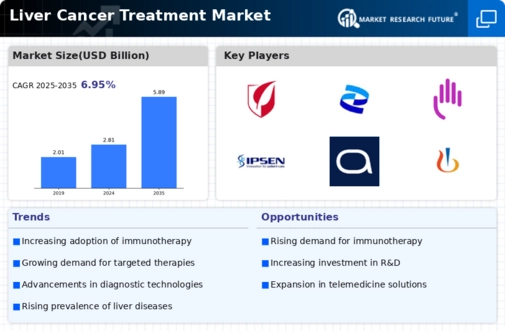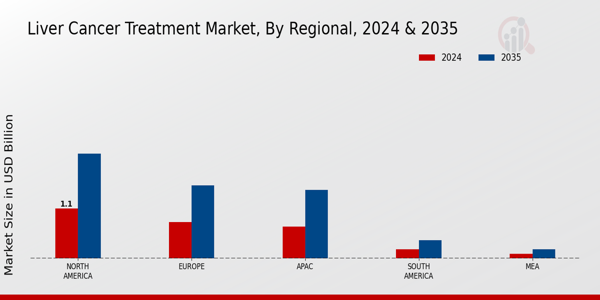Growing Incidence of Liver Cancer
The rising incidence of liver cancer is a primary driver for the Liver Cancer Treatment Market. According to recent statistics, liver cancer cases have been steadily increasing, with an estimated 1 million new cases projected by 2025. This alarming trend is attributed to factors such as hepatitis infections, alcohol consumption, and obesity. As the prevalence of liver cancer escalates, the demand for effective treatment options intensifies. Healthcare providers are compelled to invest in innovative therapies and technologies to address this growing health crisis. Consequently, pharmaceutical companies are focusing on developing new drugs and treatment modalities, thereby propelling the Liver Cancer Treatment Market forward. The increasing awareness of liver cancer symptoms and the importance of early diagnosis further contribute to the market's expansion, as patients seek timely interventions.
Increasing Investment in Cancer Research
The surge in investment for cancer research is a pivotal driver for the Liver Cancer Treatment Market. Governments and private organizations are allocating substantial funds to explore novel treatment options and improve existing therapies. In recent years, funding for liver cancer research has seen a notable increase, with billions of dollars directed towards clinical trials and innovative drug development. This financial support not only accelerates the pace of research but also encourages collaboration among academic institutions, pharmaceutical companies, and healthcare providers. As a result, the Liver Cancer Treatment Market is likely to benefit from the introduction of groundbreaking therapies and treatment protocols. The emphasis on research and development is expected to yield new insights into liver cancer biology, ultimately leading to more effective and targeted treatment strategies.
Rising Awareness and Education Initiatives
Rising awareness and education initiatives regarding liver cancer are significantly influencing the Liver Cancer Treatment Market. Public health campaigns aimed at educating individuals about the risk factors, symptoms, and importance of early detection are gaining momentum. These initiatives are crucial in promoting regular screenings and encouraging individuals to seek medical attention promptly. As awareness increases, more patients are likely to be diagnosed at earlier stages, which can lead to better treatment outcomes. Healthcare providers are also focusing on educating their staff and patients about the latest treatment options available. This heightened awareness not only drives demand for liver cancer treatments but also fosters a more informed patient population, which is essential for the growth of the Liver Cancer Treatment Market.
Regulatory Support for Innovative Therapies
Regulatory support for innovative therapies is emerging as a significant driver for the Liver Cancer Treatment Market. Regulatory agencies are increasingly recognizing the need for expedited approval processes for breakthrough therapies that demonstrate potential in treating liver cancer. Initiatives such as accelerated approval pathways and priority review designations are encouraging pharmaceutical companies to invest in research and development. This supportive regulatory environment is likely to facilitate the introduction of novel treatment options, including targeted therapies and immunotherapies, into the market. As a result, the Liver Cancer Treatment Market is expected to experience accelerated growth, as patients gain access to cutting-edge therapies that may improve survival rates and quality of life. The collaboration between regulatory bodies and industry stakeholders is crucial in fostering innovation and ensuring that effective treatments reach patients in a timely manner.
Technological Advancements in Treatment Modalities
Technological advancements play a crucial role in shaping the Liver Cancer Treatment Market. Innovations in medical technology, such as minimally invasive surgical techniques, targeted therapies, and advanced imaging modalities, have revolutionized treatment approaches. For instance, the introduction of radiofrequency ablation and transarterial chemoembolization has improved patient outcomes and reduced recovery times. Furthermore, the integration of artificial intelligence in diagnostic processes enhances the accuracy of liver cancer detection, leading to timely interventions. As these technologies continue to evolve, they are likely to attract significant investments from both public and private sectors, thereby fostering growth in the Liver Cancer Treatment Market. The ongoing research and development efforts aimed at creating more effective and personalized treatment options are expected to further stimulate market expansion.


















Leave a Comment